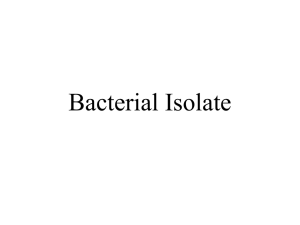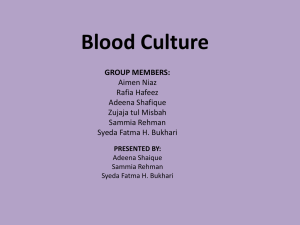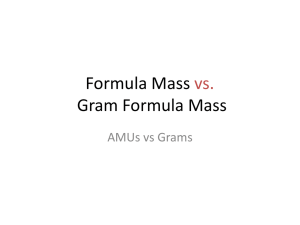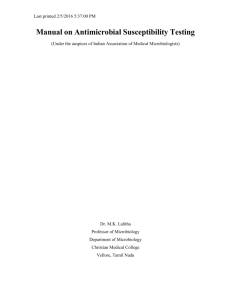Resistant - Pathology
advertisement
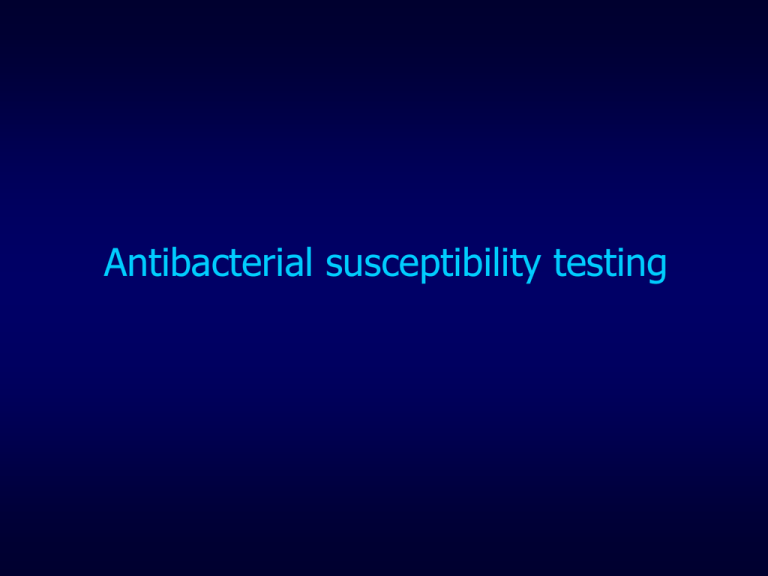
Antibacterial susceptibility testing Drug classes Methods for testing Laboratory strategies Basic principles of antimicrobial action 1. Agent is in active form - pharmacodynamics: structure & route 2. Achieve sufficient levels at site of infection - pharmacokinetics Anatomic distribution Ampicillin Ceftriaxone Vancomycin Ciprofloxacin Gentamicin Clindamycin Norfloxacin Nitrofurantoin Serum CSF Urine + + + + + + - + + ± ± - + + + + + + + Basic principles of antimicrobial action 3. Adsorption of drug by organism 4. Intracellular uptake 5. Target binding 6. Growth inhibition (bacteriostatic) or death (bactericidal) - Resistance can develop at any point Mechanisms of action Beta-lactams Penicillins, cephalosporins, carbapenems Inhibit cell wall synthesis by binding PBPs Active against many Gram + and Gram – (varies) Aminoglycosides Gentamicin, tobramycin, amikacin, streptomycin Inhibit protein synthesis (30S ribosomal subunit) Gram + and Gram – but not anaerobes Beta-lactams http://www.life.umd.edu/classroom/bsci424/Definitions.htm Aminoglycosides http://gsbs.utmb.edu/microbook/ch011.htm Mechanisms of action Fluoroquinolones Ciprofloxacin, levofloxacin Inhibit DNA synthesis by binding to gyrases Active against many Gram + and Gram – (varies) Glycopeptides Vancomycin Inhibit cell wall synthesis by binding precursors Gram + only Quinolones Glycopeptide http://gsbs.utmb.edu/microbook/ch011.htm Mechanisms of action Macrolides-lincosamides Erythromycin, azithromycin, clindamycin Inhibit protein synthesis (50S ribosomal subunit) Most Gram + and some Gram – Tetracyclines Tetracycline, doxycycline Inhibit protein synthesis (30S ribosomal subunit) Gram + and Gram – and intracellular orgs. Macrolides Tetracycline http://gsbs.utmb.edu/microbook/ch011.htm Mechanisms of action Oxazolidinones Linezolid Inhibit protein synthesis (50S ribosomal subunit) Gram + and Gram – including multi-resistant Streptogramins Quinupristin/dalfopristin (Synercid) Inhibit protein sythesis (50S ribosomal subunit) Primarily Gram + organisms Linezolid Streptogramins http://www.kcom.edu/faculty/chamberlain/Website/Lects/Metabo.htm Mechanisms of action Trimethoprim Sulfonamides Usually combined (Trimeth/sulfa) Inhibit different parts of folic acid pathway affects DNA synthesis Gram + and many Gram – http://gsbs.utmb.edu/microbook/ch011.htm Mechanisms of resistance Biologic - physiologic changes resulting in a decrease in susceptibility Clinical - physiologic changes have progressed to a point where drug is no longer clinically useful Mechanisms of resistance Environmentally-mediated Physical or chemical characteristics that alter the agent or the organism’s physiologic response to the drug pH anaerobiasis cations metabolites Mechanisms of resistance Microorganism-mediated Intrinsic predictable Gram neg vs. vancomycin (uptake) Klebsiella vs. ampicillin (AmpC) Aerobes vs. metronidazole (anaerobic activation) Mechanisms of resistance Microorganism-mediated Acquired unpredictable - this is why we test - mutations, gene transfer, or combination Mechanisms of resistance These factors are taken into account to attempt to standardize in vitro testing methods. In vitro methods are not designed to recreate in vivo physiology. In vivo physiology affects clinical response such that in vitro testing cannot be used to predict clinical outcome. Mechanisms of resistance Common pathways 1. Enzymatic degradation or modification of agent 2. Decreased uptake or accumulation of agent 3. Altered target 4. Circumvention of consequences of agent 5. Uncoupling of agent-target interactions 6. Any combination of above Emergence of resistance Mixing of bacterial gene pool Selective pressure from excessive antimicrobial use and abuse Survival of the fittest Emergence of resistance 1. Emergence of new genes - MRSA, VRE, GISA 2. Spread of old genes to new hosts - Pen resistant GC , GRSA 3. Mutations of old genes resulting in more potent resistance - ESBLs 4. Emergence of intrinsically resistant opportunistic bacteria - Stenatrophomonas Methods for detecting resistance Goal: To determine whether organism expresses resistances to agents potentially used for therapy Designed to determine extent of acquired resistance Methods for detecting resistance Goals of standardization 1. Optimize growth conditions 2. Maintain integrity of antimicrobial agent 3. Maintain reproducibility and consistency Methods for detecting resistance National Committee for Clinical Laboratory Standards (NCCLS) Name changed to: Clinical Laboratory Standards Institute (CLSI) Methods for detecting resistance Standardization Limits: In no way mimic in vivo environment Results cannot predict outcome because of: - diffusion in tissue and host cells - serum protein binding - drug interactions - host immune status and underlying illness - virulence of organism - site and severity of infection Methods for detecting resistance Standardization Inoculum size Growth medium Incubation atmosphere, temperature, duration Antimicrobial concentrations used Methods for detecting resistance Inoculum preparation Standardized inoculum size using turbidity standard McFarland standard: mixing various volumes of 1% sulfuric acid and 1.175% barium chloride 0.5 McFarland = 1.5 x 108 CFU/mL Adjust by eye or using instrument Methods for detecting resistance Growth media Mueller-Hinton pH Cation conc. Blood and serum suppl. Thymidine content Thickness Methods for detecting resistance Incubation conditions Temperature: 35°C Atmosphere: room air (most) 5 – 10% CO2 (fastidious) Methods for detecting resistance Incubation time GNR: 16 – 18 hrs. GPC: 24 hrs. Methods for detecting resistance Selection of antimicrobial agents Organism identification or group Acquired resistance patterns of local flora Testing method used Site of infection Formulary Methods for detecting resistance Directly measure the activity of one or more antimicrobial agents against an isolate Directly measure the presence of a specific resistance mechanism in an isolate Measure complex interactions between agent and organism Detect specific genes which confer resistance Methods for detecting resistance Directly measure antimicrobial activity Conventional methods Broth dilution Agar dilution Disk diffusion Commercial systems Special screens and indicator tests Conventional methods Inoculum preparation for manual methods Pure culture, 4 – 5 isolated colonies, 16 – 24 hrs old GNR: inoculated into broth and incubated until reaching log phase GPC: suspended in broth or saline and tested directly Conventional methods Broth dilution Various concentrations of agent in broth Range varies for each drug Typically tested at doubling dilutions Minimum inhibitory concentration (MIC): lowest concentration required to visibly inhibit growth Conventional methods Broth dilution Microdilution: testing volume 0.05 – 0.1 mL Macrodilution: testing volume >1.0 mL Final concentration of organism: 5 x 105 CFU/mL Conventional methods Agar dilution Doubling dilution is incorporated into agar Multiple isolates tested on each plate Final amount of organism spotted: 1 x 104 CFU Visually examine for growth, determine MIC Conventional methods Disk diffusion (Kirby-Bauer) Surface of agar plate seeded with lawn of test organism Inoculum: swab from 0.5 McFarland Disks containing known conc. of agent placed on surface of plate Measure diameter of zone of inhibition Conventional methods Disk diffusion Zone sizes have been correlated with MICs to establish interpretive criteria Typically, 12 – 13 disks can be placed on each plate Conventional methods Antibiotic gradient diffusion Agent is applied in gradient to a test strip Plate is seeded with organism as in KB Agent diffuses away from strip to inhibit growth Etest (AB BIODISK, Sweden) Interpretive categories Susceptible: agent may be appropriate for therapy; resistance is absent or clinically insignificant Intermediate: agent may be useful if conc. at site of infection; may not be as useful as susceptible agent; serves as safety margin for variability in testing Resistant: agent may not be appropriate for therapy; inhibitable dose not acheivable or organism possesses resistance mechanism Automated systems Manual preparation of isolate suspension Manual – completely automated inoculation Automated incubation, reading of results Automated interpretation and data management MicroScan WalkAway Dade-Behring VITEK 2, BioMerieux Supplemental testing methods Screening agar Agar contains known conc. of antibiotic Growth on agar indicates resistance Oxacillin screening agar: 6 g/ml oxacillin Screening of staphylococci Vancomycin screening agar: 6 g/ml vanco Screening of enterococci and staphylococci Supplemental testing methods Predictor drugs Staphylococci R to Oxacillin = R to penicillins, cephalosporins, and imipenem High level gentimicin R in enterococci = R to all currently available aminoglycosides Ampicillin R in enterococci = R to all penicillin derivatives and imipenem Direct detection of resistance mechanisms Beta-lactamase (phenotypic) Chromogenic substrate incorporated into disk - color change in presence of enzyme Usefulness is limited: Pen R in GC Amp R in H. flu Pen R in anaerobes Direct detection of resistance mechanisms Extended spectrum beta-lactamase Mutations in plasmid-encoded beta-lactamases - hydrolyze extended spectrum cephalosporins and aztreonam - more than 100 types have been identified - isolates are often resistant to other classes Interpretive criteria available for: - E. coli, K. pneumoniae, K. oxytoca, P. mirabilis Direct detection of resistance mechanisms Extended spectrum beta-lactamase Screen with aztreonam or cefpodoxime R = requires confirmatory testing Confirmatory testing: Ceftazidime v. ceftaz + clavulanic acid Cefotaxime v. cefotax + clavulanic acid KB: >/= 5 mm increase w/ BLI MIC: >/= 3-fold decr in MIC w/ BLI Direct detection of resistance mechanisms Oxacillin R due to PBP2a (phenotypic) Latex agglutination test to detect altered PBP in staphylococci Presence confers resistance to Ox Depends on expression of protein Direct detection of resistance mechanisms Oxacillin R due to PBP2a (genotypic) PCR to detect mecA gene in staphylococci Positive not dependent on expression Direct detection of resistance mechanisms Inducible clindamycin resistance (D test) Resistance to macrolides can occur through: efflux (msrA) ribosome alteration (erm) Erythro R Clinda S msrA or inducible erm Erythro R Clinda R constitutive erm L: Erythro, R: Clinda No resistance Inducible erm Efflux Constitutive erm Laboratory strategies for testing Goals of effective strategies include: Relevance Accuracy Communication Laboratory strategies for testing Criteria used for assessing relevance: Clinical significance of isolate Predictability of susceptibility against drugs of choice Availability of reliable standardized methods Selection of appropriate agents Laboratory strategies for testing Clinical significance Abundance in direct smear Ability to cause disease in that body site Colonizer or pathogen? Body site of isolation Laboratory strategies for testing Predictability of susceptibility Testing not required when susceptibility is predictable Pen S in beta-hemolytic streptococci Ceph S in GC Clinical requirements can result in exceptions Laboratory strategies for testing Availability of standardized methods Testing cannot be performed if standardized method does not exist Method and interpretive guidelines required Info available for most pathogenic bacteria Fungi, Nocardia, AFB Laboratory strategies for testing Selection of agents Previously discussed criteria: Organism ID or group Acquired resistance patterns Testing method used Site of infection Formulary Laboratory strategies for testing Communication Prompt and thorough review of results Prompt resolution of unusual results Augment susceptibility reports with messages that help clarify and explain potential therapeutic problems not necessarily evident by data alone



